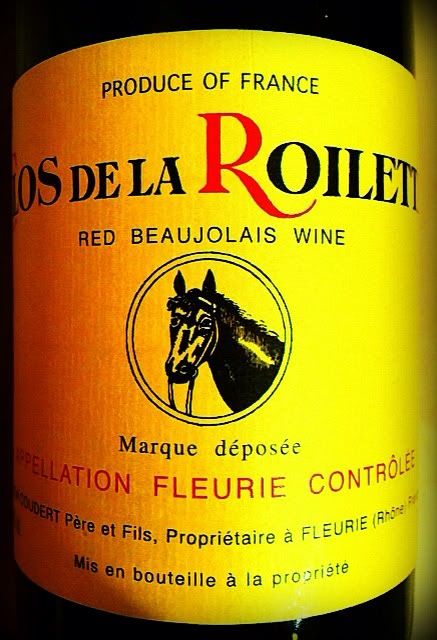This taste of the Beaujolais region concerns a wine by Alain Coudert, Clos de la Roilette, Fleurie 2010. The label indicates it's a red Beaujolais wine - 99% of the wine from Beaujolais is red, produced from the Gamay grape.
Fleurie wines are often indicated as having a fruity and floral bouquet. That would be underselling the case, here, as we will find in a bit.
Louis Dressner Selections imports this wine, and their website describes the evolution of Clos de la Roilette:
"In the '20s, when the Fleurie appellation was first created, the former landowner was infuriated with losing the Moulin-à-Vent appellation under which the clos had previously been classified. He created a label, using a photograph of his racehorse Roilette, and used the name Clos de la Roilette, without mentioning Fleurie. The owner vowed not to sell a drop of his wine on the French market and the production went to Switzerland, Germany and England."By the mid-1960s, the owner’s heirs had lost interest in the clos and a large portion of the land had gone wild and untended. In 1967, Fernand Coudert bought this poorly maintained estate, and replanted the vineyards. His son Alain joined him in 1984, and has been the winemaker since."
The racehorse remains on the label to this day, although the Couderts apparently have no ill will at this point about the appellation. The wine is labeled as Fleurie.
This is a complex Beaujolais Cru which retails for $20 and is a little stronger than a typical Beaujolais at 13% abv. The average age of the Coudert's vines are 25-33 years and I am told it should age well for 5-10 years.
An initial cork sniff had me thinking I'd opened a bottle of sherry by mistake. There's a huge nuttiness and something akin to caramel on the cork. Once in the glass, the nose of the medium dark wine displays leathery cherry fruit, allspice and a hint of something burnt.
The palate is equally serious. A very dark expression of cherries and roast come forward right away, and an almost muddy taste plays with the fruit as it shows black cherry, then blackberry, then a campfire flavor. There is a fantastic acidity and a lingering tartness which begs for another sip to be taken.
In my sedentary travel through the Beaujolais crus, this is the darkest and most impressive wine I have tasted.

No comments:
Post a Comment